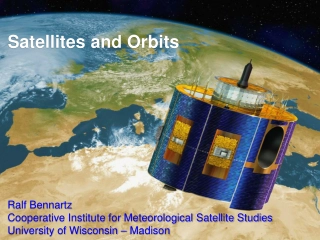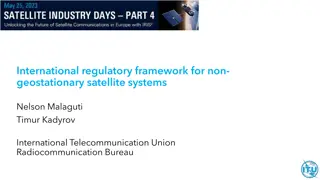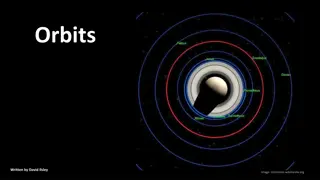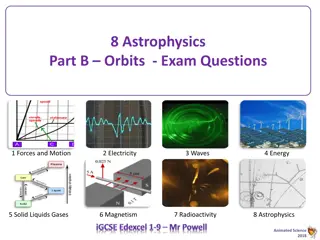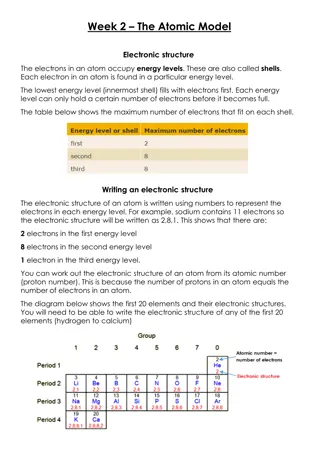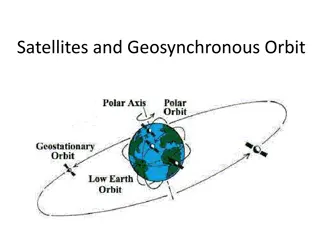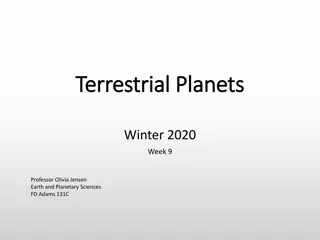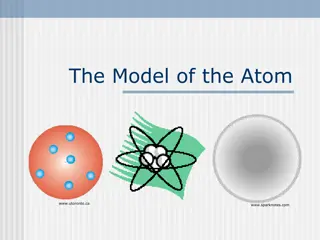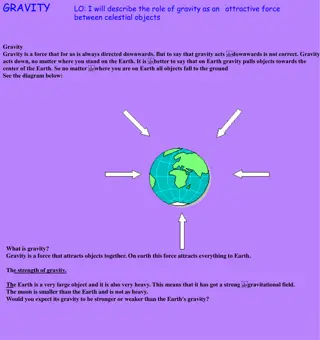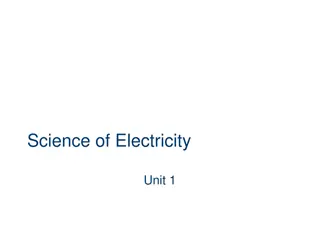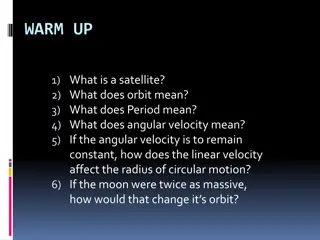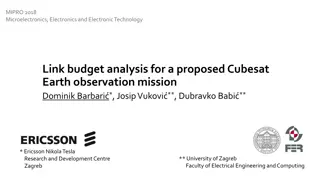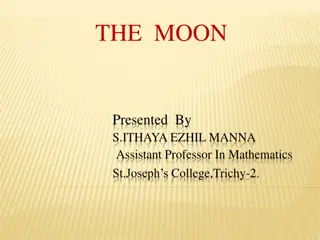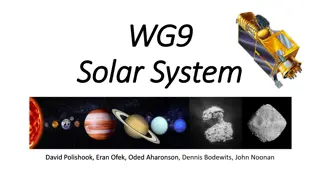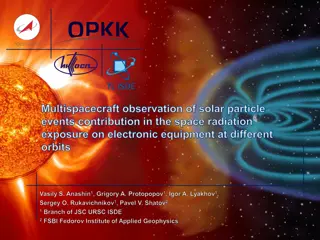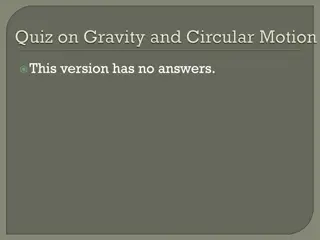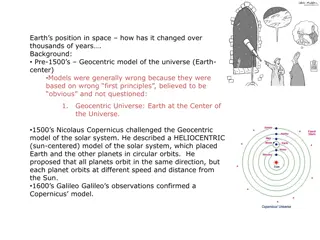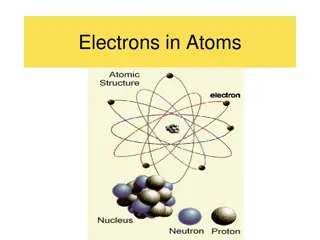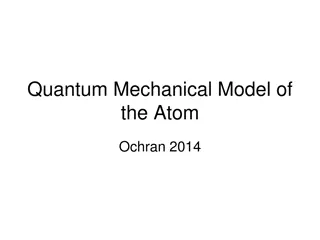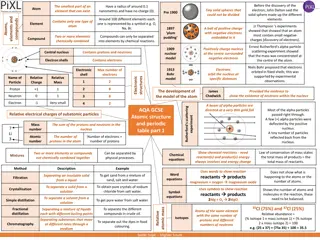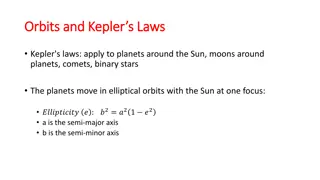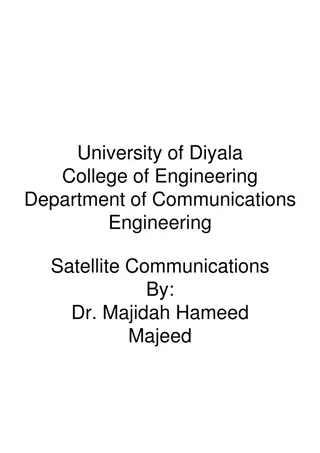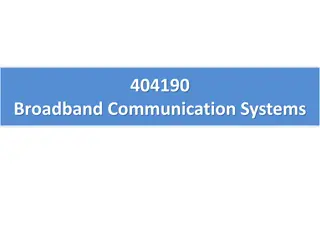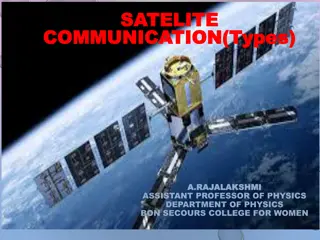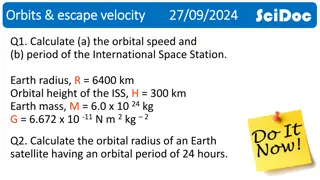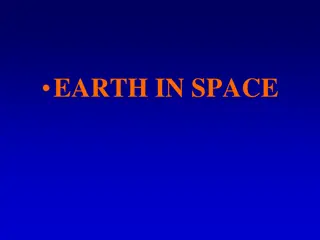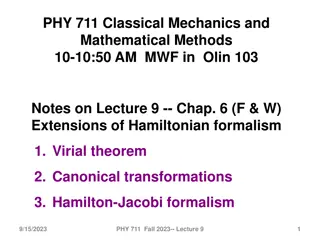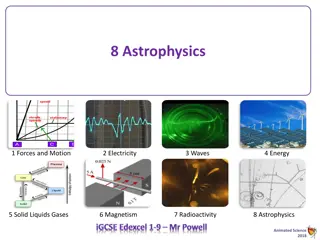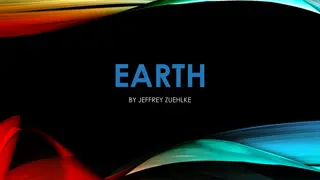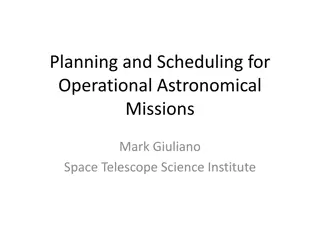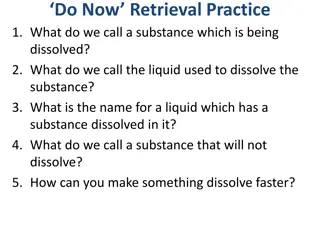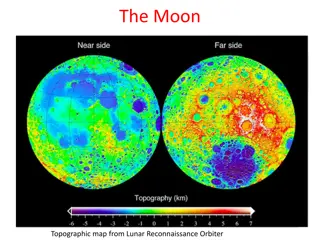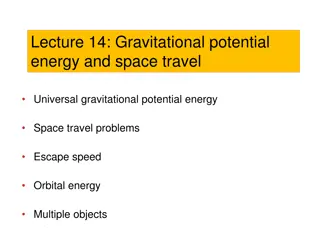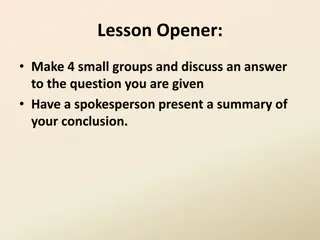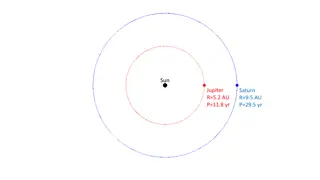Satellites and Orbits
The realm of satellites and orbits, covering topics such as Kepler's Laws, meteorological satellite orbits, the history of satellite remote sensing, and different types of orbits including geostationary and sun-synchronous orbits. Explore the significance of inclination angles, orbital speeds, and d
3 views • 22 slides
International Regulatory Framework for Non-Geostationary Satellite Systems
Understanding the international regulatory framework for non-geostationary satellite systems, including coordination for protection of existing services, spectrum access/use laws, satellite frequencies and services, and mechanisms for protecting geostationary satellite orbits. The regulations aim to
2 views • 17 slides
Orbits and Gravity in Space
Explore the concept of orbits and gravity in space by following the trajectory of a satellite above Earth. Learn how gravity keeps the satellite in a perpetual state of orbit, moving at a constant speed parallel to the ground due to the Earth's round shape. Discover how varying speeds affect orbit s
1 views • 34 slides
Orbits and Motion in Astrophysics
Explore the concept of orbits and motion in astrophysics, covering gravitational forces, planetary orbits, orbital speeds, and celestial phenomena like lunar eclipses. Delve into how objects move in space, the relationships between orbital speed, radius, and time period, and the dynamics of celestia
1 views • 14 slides
Magnetic Field Problems: Protons, Wires, and Charged Ions
Solve various problems related to magnetic fields, including determining forces on protons, calculating magnetic forces on wires with currents, finding the radius of paths for charged ions in magnetic fields, and more. Understand concepts such as magnetic forces, circular orbits, and interactions be
2 views • 10 slides
Atomic Structure: Electrons, Energy Levels, and Historical Models
The atomic model describes how electrons occupy energy levels or shells in an atom. These energy levels have specific capacities for electrons. The electronic structure of an atom is represented by numbers indicating electron distribution. Over time, scientists have developed atomic models based on
1 views • 5 slides
Exploring the Twelvefold Way in Combinatorics
The Twelvefold Way in combinatorics classifies enumerative problems related to finite sets, focusing on functions from set N to set X under various conditions like injective or surjective. It considers equivalence relations and orbits under group actions, providing a systematic approach to counting
4 views • 15 slides
Satellite Orbits and Space Missions
This content covers a variety of topics related to satellites, including geosynchronous orbit, satellite history, organisms sent to orbit, types of orbits, orbital altitudes, and current satellite usage. It delves into the history of satellite launches, types of orbits, and the functions of satellit
0 views • 20 slides
Orbital Dynamics: Kepler's Laws and Newtonian Gravity
Delve into the fascinating world of orbital dynamics as we explore Kepler's Laws and Newtonian Gravity. From understanding the elliptical orbits of planets around the Sun to uncovering the role of gravity in shaping celestial motion, this journey will illuminate the fundamental principles governing
0 views • 18 slides
European Deep Space Surveillance and Tracking Collaboration
EU Space Surveillance and Tracking program involves five European nations collaborating to assess and reduce risks to European spacecraft, provide early warnings for re-entries and space debris, and prevent space debris proliferation. Available deep space sensors, such as optical telescopes, are uti
1 views • 8 slides
Evolution of Atomic Models: From Thomson to Bohr
Scientists from J.J. Thomson to Niels Bohr made groundbreaking discoveries in understanding the structure of the atom. Thomson's plum-pudding model was followed by Rutherford's nuclear model, revealing the nucleus. Bohr introduced the concept of discrete energy levels and orbits for electrons. These
4 views • 22 slides
Gravity: A Fundamental Force in the Universe
Gravity is a ubiquitous force that attracts celestial objects towards each other, playing a crucial role in keeping planets in their orbits around the Sun and moons around their parent planets. This force, described by Newton's laws, is responsible for phenomena like tides and maintaining the motion
0 views • 7 slides
Electricity at the Atomic Level
Explore the fascinating world of electricity at the atomic level, delving into concepts such as the movement of electrons, components of an atom, electron orbits, atomic numbers, and the behavior of elements like copper and sulfur. Discover how these fundamental principles shape the properties of ma
0 views • 28 slides
Satellite Orbits and Motion
Explore the concepts of satellites, orbits, period, and angular velocity in relation to circular motion. Learn how these factors affect the motion of objects in space and understand the relationship between linear and angular velocity. Discover the impact of mass on an object's orbit and how it infl
0 views • 7 slides
Link Budget Analysis for Cubesat Earth Observation Mission
This research paper discusses the link budget analysis for a proposed Cubesat Earth observation mission, covering aspects such as Cubesat dimensions, mission objectives, communication parameters, orbital mechanics, and current missions in various frequency bands. Key topics include mapping light pol
0 views • 24 slides
The Moon: A Celestial Neighbor
The moon, Earth's closest celestial neighbor, orbits the Earth following Kepler's laws. With a distance of about 240,000 miles and a linear diameter of 2163 miles, the moon's mass is about 1/81 times that of Earth. Learn about the lunar orbit, nodes, and its relationship with synodic and sidereal mo
0 views • 11 slides
Exploration of Asteroid Taxonomic Groups and Compositional Structure
Delve into the classification and analysis of varied asteroid taxonomic groups such as Silicate (S-type) and carbonaceous (C-type). Utilize NUV photometry data to distinguish between asteroid sub-groups and study compositional structures in the main asteroid belt. Investigate the dynamics of primiti
0 views • 10 slides
Space Radiation Exposure on Electronic Equipment in Various Orbits
Discover the impact of solar particle events on space radiation exposure for electronic equipment at different orbits through multispacecraft observations. Explore the absorbed doses, effects on onboard sensors, and implications for spacecraft operations. Gain insights into the influence of space ra
0 views • 20 slides
Concepts in Gravitational Forces and Celestial Bodies
This informative content delves into various concepts related to gravitational forces and interactions between celestial bodies like the Earth and the Moon. It covers topics such as the comparison of gravitational pulls, forces in concentric orbits, weight measurements in different scenarios, and th
0 views • 11 slides
Physics Concepts Review: Motion and Forces
Explore essential concepts in physics related to motion and forces, including forces acting against falling objects, gravitational forces, momentum, inertia, and more. Test your knowledge with questions on gravity, air resistance, satellite orbits, and the law of universal gravitation.
0 views • 17 slides
Exploring the Solar System: Planets, Orbits, and More
Dive into the fascinating world of the solar system with this chapter on Astronomy. Learn about planets, moons, asteroids, comets, and more as they orbit the Sun. Understand the forces of gravity and inertia that keep celestial bodies in motion and explore ancient ideas about planetary motion. Disco
0 views • 26 slides
Evolution of Earth's Position in Space Over Millennia
Before the 1500s, the geocentric model placed Earth at the center of the universe, which was later challenged by Copernicus with a heliocentric model. Kepler's laws further refined our understanding, particularly the first law focusing on planetary motion in elliptical orbits. This experiment demons
0 views • 19 slides
Evolution of Atomic Models: From Dalton to Bohr
Explore the progression of atomic models from John Dalton's theory of tiny, structureless particles to J.J. Thomson's Plum Pudding model, Ernest Rutherford's discovery of the nucleus, and finally Niels Bohr's model with fixed electron orbits and energy levels. Witness the journey of scientific under
0 views • 28 slides
Evolution of Atomic Models: From Rutherford to Quantum Mechanics
Various atomic models have been proposed throughout history, starting with John Dalton's idea of atoms as tiny particles to J.J. Thomson's Plum Pudding model. Ernest Rutherford's discovery of the nucleus and Niels Bohr's quantum model of the atom revolutionized our understanding. Bohr's proposal of
0 views • 38 slides
Development of the Atomic Model: From Dalton to Rutherford
Before the discovery of the electron, John Dalton proposed the solid sphere model for elements, while JJ Thomson's experiments led to the discovery of electrons. Ernest Rutherford's alpha particle scattering experiment revealed the concentrated mass at the nucleus, which formed the basis of the nucl
0 views • 4 slides
Orbits and Kepler's Laws in Astronomy
Orbits and Kepler's Laws play a crucial role in understanding the movement of planets, moons, comets, and binary stars in our universe. Kepler's laws describe the elliptical orbits of planets around the Sun, the equal area law, and the relationship between a planet's distance from the Sun and its or
0 views • 29 slides
Satellite Communications and Orbits in Engineering
Exploring the intricacies of satellite communications and orbits in engineering, focusing on special types of inclined orbits, circular orbits, elliptic orbits, and the calculation of eccentricity. Examples such as the International Space Station's orbit are used to illustrate concepts. The content
0 views • 17 slides
Broadband Communication Systems and Satellite Communications
Broadband communication systems involve the use of satellites for various applications such as TV services, data services, and communication with ships and aircraft. This content delves into orbital mechanics, the gravitational forces in satellite orbits, as well as the orbital heights and velocitie
0 views • 57 slides
Different Types of Satellite Communication Orbits
Explore the various types of satellite communication orbits, including Geostationary Earth Orbit (GEO), Low Earth Orbit (LEO), Medium Earth Orbit (MEO), and Highly Earth Orbit (HEO). Learn about the advantages and disadvantages of each orbit in relation to satellite communication technologies.
0 views • 8 slides
Orbital Mechanics and Satellites Overview
This content provides calculations for the orbital speed and period of the International Space Station, as well as the orbital radius of an Earth satellite with a 24-hour period. It explains the concept of artificial satellites, different types of orbits such as Low Earth Orbit (LEO), Medium Earth O
0 views • 17 slides
Unveiling Earth: Exploring the Planet's Shape, Size, and Motions
Delve into Earth's fascinating characteristics through images and insights. Discover how ancient thinkers like Eratosthenes calculated its circumference, the reasons why it was believed to be a perfect sphere, and modern findings revealing its oblate nature with poles of different heights. Explore E
0 views • 62 slides
Extensions of Hamiltonian Formalism in Classical Mechanics and Mathematical Methods
Lecture 9 on the extensions of Hamiltonian formalism covers topics such as the Virial theorem, canonical transformations, and the Hamilton-Jacobi formalism. It delves into proofs and examples related to the Virial theorem, including applications to the harmonic oscillator and circular orbits in grav
1 views • 26 slides
Astrophysics: Forces, Motion, and Gravitational Fields
Explore the realm of astrophysics through forces, motion, energy, and gravitational fields. Delve into topics like orbits, velocity, and the fundamental units of measurement, all depicted in engaging visual representations. Gain insights into the vastness of the universe, galaxies, stars, and planet
0 views • 9 slides
Based on the provided content, here are the requested elements: "Journey through our Solar System
Explore the wonders of our Solar System, from our home planet Earth to the rocky and gas giants, learning about their unique characteristics, orbits, and rotations. Discover how each planet plays a vital role in the vast expanse of space surrounding the Sun.
0 views • 11 slides
Astronomical Planning and Scheduling for Scientific Missions
Explore the operational aspects of astronomical missions led by the Space Telescope Science Institute, covering the Hubble Space Telescope and the upcoming James Webb Space Telescope. Learn about the goals, features, constraints, and use cases of planning and scheduling, along with mission character
0 views • 43 slides
Our Solar System and Orbits
Explore the composition and orbits of our solar system, including the Sun, planets, dwarf planets, moons, comets, asteroids, and artificial satellites. Understand the role of gravity in maintaining nearly circular orbits and discover how objects stay in orbit.
0 views • 11 slides
The Moon: Topographic Features and Formation
The moon, with a radius 0.27 of Earth, orbits the Earth every 27.3 days and is tidally locked with one face always pointing towards Earth. It has a composition similar to Earth's rocks and likely formed from a giant impact. The moon's surface features craters and dark patches called maria, while the
0 views • 13 slides
Gravitational Potential Energy and Space Travel
Explore the concepts of gravitational potential energy, orbital energy, escape speed, and satellite motion in the context of space travel. Learn about critical escape conditions, escape speeds from Earth and orbit, and the speed of satellites in circular orbits. Delve into multiple objects in space
0 views • 14 slides
Gravity and Inverse Square Relationships in Physics
Explore the concepts of gravitational field, potential, geostationary orbits, escape velocity, and the inverse square relationship in Newton's Law of Universal Gravitation. Discover how mass and distance affect gravitational force and learn about nonuniform gravitational fields and equipotential lin
0 views • 22 slides
Comparing Jupiter and Saturn Orbits
This content compares the orbits of Jupiter and Saturn in the solar system, detailing their distances from the Sun, orbital periods, and mass ratios. It also hints at the different speeds at which Jupiter and Saturn are moving. The provided images showcase visual representations related to the discu
0 views • 33 slides
